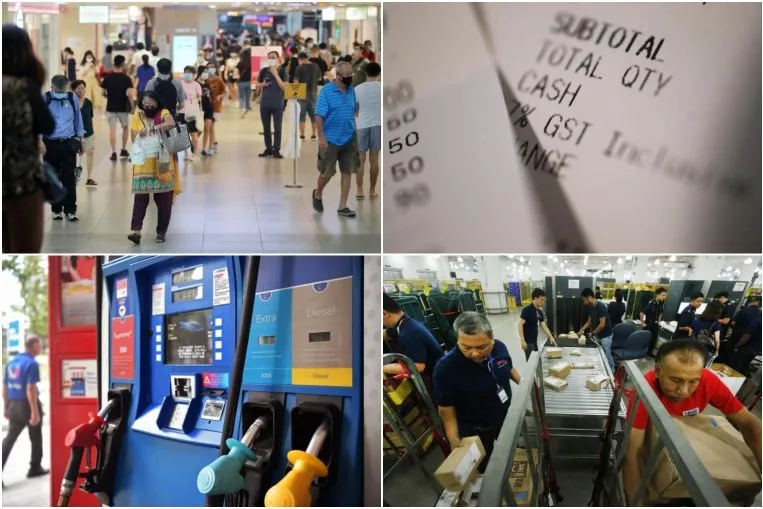2021年财政预算案亮点:从家庭代金券到进口网购低价商品所纳消费税一一盘点
提高汽油税,延长受打击最严重行业(航空等)的公司生命线。
|1 min read

<p>新加坡——新加坡副总理王瑞杰周二(2月16日)宣布了多项举措,其中包括向家庭发放代金券,延长受新冠肺炎疫情影响最严重行业的工资补贴。</p> <p>家庭将获得用于在中心地带消费的更多返现和代金券,而航空和旅游等行业的企业生命线将再延长几个月。</p> <p>以下是十大亮点:</p> <h2 id="1-100" class="“headings“">1. 为家庭提供更多的帮助,如100 元代金券</h2> <p>政府在持续的经济不稳定下将推出一个9亿元的家庭支助计划(Household Support Package)。</p> <p>该计划包括每个家庭都可以用来支付费用和支持当地企业的代金券,以及组屋杂费(S&CC)返现和消费税(GST)补助券。</p> <p>约130万户家庭将获得100 元的社区发展理事会(CDC)代金券,可在中心地带的商店和小贩中心使用。</p> <p>符合条件的新加坡组屋公寓家庭也将获得返现,可抵消一年中1个半月至3个半月的组屋杂费。</p> <p>约有140万低收入新加坡人将获得额外的消费税补助券(除了常规的消费税补助券发放外,还将在六月获得200 元的特别现金补助)。</p> <p>约95万户家庭还将从四月和七月发放的消费税补助券—水电费回扣特别补助金(GST Voucher - U-Save Special Payment)中获得120至200 元的额外水电费返现。这意味着他们将获得1.5倍的以往年度返现。</p> <p>21岁以下的新加坡儿童可在他们的儿童培育账户(Child Development Account)、教育储蓄(Edusave)账户或中学后延续教育(Post-Secondary Education)账户里获得200 元的充值。大约78万儿童将从中受益。</p> <h2 id="2-20222025" class="“headings“">2. 消费税将在2022年至2025年上调,“越早越好”</h2> <p><img src="https://imgur.com/FvwVTs1.jpg"></p> <p>正如去年财政预算案中宣布的那样,消费税率由7 %提高两个百分点至9 %将不会在今年实施。</p> <p>不过,王瑞杰表示,取决于经济前景,这项举措将在明年至2025年之间实施,并且“越早越好”。他补充说,如果不提高消费税,新加坡将无法满足其不断增长的经常性支出需求,特别是在医疗保健方面的需求。</p> <p>政府先前宣布了60亿元的定心与援助计划(Assurance Package),以缓冲增税带来的影响。</p> <h2 id="3" class="“headings“">3. 开始为进口网购的低价商品支付消费税</h2> <p>从2023年1月1日起,通过空运或邮寄进口的网购低价商品将需缴纳消费税。</p> <p>消费税缴纳也将延申至为消费者提供的进口非数字服务,比如那些与健身培训、咨询和远程医疗的海外提供商进行实时交流的服务。</p> <p>王瑞杰表示,这将有助于为本地企业提供公平的竞争环境,以实现有效竞争。</p> <p>目前,价值不超过400 元的空运或邮寄进口的低价商品无需缴纳消费税,以方便通关,但应在本地购买的此类商品则需要缴税。</p> <p>所有通过陆路或海上进口的商品都已被征税,不论其多少价值。</p> <p>王瑞杰说,海外商品和服务的供应商将受到与本地供应商相同的消费税待遇。</p> <h2 id="4" class="“headings“">4. 支付更多的汽油费用</h2> <p><img src="https://imgur.com/tTbtII7.jpg"></p> <p>新加坡正努力成为一个少用汽车的社会,驾车者现在必须支付更多的油钱。</p> <p>高品质(98-辛烷值及以上)汽油的税率将每升提高15分,至每升79分,而中品质(92-辛烷值和95-辛烷值)汽油的税率将每升提高10分,至每升66分。</p> <p>新加坡人将会有返现来缓解这个过渡时期,特别是那些以开车为生计的人。</p> <p>出租车和私召车司机将获得一年15 %的道路税返税,并在四个月内获得360 元的额外汽油税返税。使用汽油的汽车将获得一年15 %的返税。</p> <p>所有道路税变更适用期为一年,从2021年8月1日至2022年7月31日。</p> <h2 id="5" class="“headings“">5. 延长受新冠疫情影响最严重行业的雇佣补贴计划</h2> <p>为帮助仍受新冠疫情严重影响的企业保留员工,雇佣补贴计划下的工资补贴将再延长六个月。</p> <p>补贴从10 %到30 %不等,将涵盖受危机影响最严重的行业(航空、航天和旅游业)其公司4月至9月的工资。</p> <p>对于在食品服务、零售、海洋离岸以及艺术娱乐等其他遭受重创的行业的公司,补贴将从4月延长至6月。</p> <p>为了促进工人去增长地区就业,政府将延长“新心相连”就业与技能配套(SGUnited Jobs and Skills Package)中的特定计划。</p> <p>加薪补贴计划(Wage Credit Scheme)也将延长一年,以15 %的共同资助水平进一步支持工资增长,以便企业可以保留和吸引当地员工。</p> <p>护士和其他医护人员(如辅助护理人员)的工资也会提高。</p> <h2 id="6-2023s-pass15" class="“headings“">6. 到2023年,制造业外籍劳工的S Pass配额将削减至15 %</h2> <p>从明年1月1日起,持有S Pass工作证的外籍劳工最多只能占制造业企业劳动力的18 %。</p> <p>从2023年1月1日起,这一配额将进一步削减至15 %。目前该配额是20 %。</p> <p>制造业的总配额(包括获得工作许可证和S Pass工作证的工人)将保持在60 %。</p> <h2 id="7-110covid-19-resilience-package" class="“headings“">7. 110亿元的“应对冠病坚韧配套”(Covid-19 Resilience Package)</h2> <p>政府将拨出110亿元的“应对冠病坚韧配套”以促进新加坡从新冠疫情中复苏。其中48亿元将用于保障公众健康,包括为每个符合条件的人提供免费的疫苗接种。</p> <p>政府旨在利用过去的储备来为“应对冠病坚韧配套”提供资金。新加坡将连续第二年动用过去的储蓄来支付抗击新冠疫情所需的应对措施,从储备金中提取17亿元。这笔款项将与去年提取但未使用的93亿元合并。</p> <p>在这两个财政年度动用的储备金总额预计将达到537亿元。</p> <h2 id="8" class="“headings“">8. 更便宜的电动汽车,更多的充电点</h2> <p><img src="https://imgur.com/BFSG0NX.jpg"></p> <p>未来十年,新加坡电动汽车充电点的目标数量将增加一倍以上。</p> <p>到2030年,政府将在公共停车场和私人场所设置6万个充电点,高于此前2.8万个充电点的目标。</p> <p>王瑞杰周二表示,未来五年将拨出三千万美元用于与电动汽车相关的措施,例如增加私人住宅的充电器数量。</p> <p>为了进一步鼓励提早采用电动汽车,电动汽车和内燃机车之间的成本差异也将降低。</p> <p>从2022年1月至2023年12月,电动汽车的最低附加注册费(ARF)将降为零。</p> <p>目前,不管汽车是否有权获得退税,所有购车者都必须支付至少5000 元的附加注册费。</p> <h2 id="9" class="“headings“">9. 新债券用以分配财政责任</h2> <p>根据将于今年晚些时候提交议会通过的一项法律,政府将发行总额高达900亿元的新债券,为长期基础设施(如新的地铁线路)融资。</p> <p>根据拟议的“国家重大建设借贷法令”(Singa),借款限额为900亿元。这是基于未来15年主要及长期基础设施项目的预期规划而制定的。</p> <p>王瑞杰表示:“这种方式将使我们能够在几代人之间更公平地分摊这类基础设施投资的巨额成本。”</p> <p>这还将使新加坡从目前的低利率环境中受益。</p> <h2 id="10-87" class="“headings“">10. 8.7亿元支持航空业</h2> <p><img src="https://imgur.com/DNqACTW.jpg"></p> <p>政府将花费8.7亿元给予航空业额外的支持,并延长成本减免。</p> <p>王瑞杰希望该行业可以利用这段时间的旅游淡季来维持和提升自身能力,并为复苏做好准备。</p> <p>出租车和私召车司机将得到此前宣布的冠病疫情司机援助基金(COVID-19 Driver Relief Fund)的支持。政府已为此基金预留了1.33亿元。</p> <p>今年政府将延长文化艺术振兴配套(Arts and Culture Resilience Package)和体育振兴配套(Sports Resilience Package),以支持这些行业的企业和个体户。</p>

